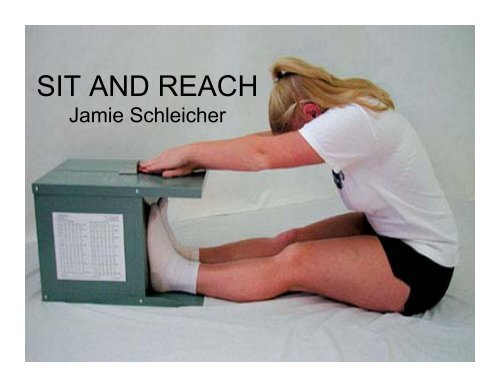SIT AND REACH - Rowan
SIT AND REACH - Rowan
SIT AND REACH - Rowan
Create successful ePaper yourself
Turn your PDF publications into a flip-book with our unique Google optimized e-Paper software.
<strong>SIT</strong> <strong>AND</strong> <strong>REACH</strong><br />
Jamie Schleicher
Who is the Sit and Reach Designed for?<br />
Intended for<br />
individuals who<br />
seek<br />
rehabilitation<br />
and to monitor<br />
the development<br />
of their<br />
hamstring and<br />
lower back<br />
flexibility.
What is the Sit and Reach?<br />
The sit and reach test<br />
is a common<br />
measure of flexibility,<br />
and specifically<br />
measures the<br />
flexibility of the lower<br />
back and hamstring<br />
muscles.<br />
This sure is<br />
stretching me<br />
out!
What are we Trying to Measure?<br />
Investigators conclude that the tests are<br />
more valid for hamstring than for back<br />
flexibility.<br />
Secondarily, it is a test for the lower<br />
back, buttocks, and calve muscles.<br />
One joints range of motion cannot<br />
predict the range of motion of another<br />
joint.
What will you Need?<br />
The sit and reach tests apparatus<br />
A box like structure<br />
Measuring scale on upper surface<br />
labeled in one centimeter intervals<br />
The 23 rd cm line is exactly in line with the vertical plane<br />
of the participants souls and heels
How Do I Perform This Test?<br />
1. Participant performs a short<br />
bout of prior exercise<br />
2. Participant removes shoes<br />
3. Participant sits on floor, bench<br />
or table with feet against the<br />
testing apparatus<br />
4. They fully extend legs with the<br />
medial sides of the feet about<br />
20 cm apart
Steps Continued<br />
About 26 cm…<br />
we’re going to<br />
have to work on<br />
your flexibility<br />
5. A second person holds one hand<br />
lightly against the participants<br />
knees to ensure full leg extension<br />
6. Participant extends arms forward<br />
with the hands placed on top of<br />
each other, palms down.<br />
7. Participant slowly bends forward<br />
along the measuring scale<br />
8. They repeat this forward stretch 2<br />
more times<br />
9. They repeat the same stretch a 4 th<br />
time, but holds both hands at the<br />
maximal position for at least 1<br />
second<br />
10. The second person observes the<br />
4 th (final) trial score to the nearest<br />
cm.
Traditional Test Scores for Men<br />
Category 18-19 years 20-25 years 20-45 years<br />
Well Above<br />
Average<br />
> 40 cm > 40 cm > 44 cm<br />
Above Average 34-40 cm 34-40 cm 36-44 cm<br />
Average 27-33 cm 24-33 cm 24-35 cm<br />
Below Average 20-26 cm 19-23 cm 16-23 cm<br />
Well Below<br />
Average<br />
< 20 cm < 19 cm
Traditional Test Scores of Women<br />
Category 18-19 years 20-25 years 20-45 years<br />
Well Above<br />
Average<br />
> 43 cm > 42 cm > 45 cm<br />
Above Average 39-43 cm 39-42 cm 40-45 cm<br />
Average 32-38 cm 32-38 cm 32-39 cm<br />
Below Average 27-31 cm 27-31 cm 26-31 cm<br />
Well Below<br />
Average<br />
< 27 cm < 27 cm
What are Other Tests?<br />
Canadian Sit and<br />
Reach Test<br />
YMCA sit and reach<br />
test<br />
Wall Sit and Reach<br />
Test<br />
V-Sit Sit and Reach<br />
Test<br />
Back-Saver Sit and<br />
Reach Test V-Sit Sit and Reach Test
Basic Characteristics of 6 Sit and<br />
Reach Tests<br />
TEST EQUIPTMENT PO<strong>SIT</strong>ION HEEL<br />
LINE<br />
(cm)<br />
Traditonal Sit and reach<br />
box<br />
Canadian Adjustable box,<br />
stick<br />
YMCA Measuring<br />
stick, tape<br />
Floor or<br />
bench<br />
Floor or<br />
bench<br />
Wall SR box, stick Floor or<br />
bench<br />
V-sit Measuring<br />
stick, tape<br />
Back-Saver SR box Floor or<br />
bench<br />
TIME<br />
HELD<br />
(sec)<br />
# of<br />
TRIALS<br />
TRIAL to<br />
RECORD<br />
23 1-2 4 4 th trial<br />
26 2 2 Best trial<br />
Floor 38 2 3 Best trial<br />
0 > 2 2 Average<br />
Floor 23 1-2 4 4 th trial<br />
23 1-2 4 per<br />
leg<br />
4 th trial
Discussion<br />
Because extreme mobility is not optimal,<br />
high flexible scores are not classified as<br />
“excellent”<br />
A non-qualitative classification system<br />
ranging from low to high is used instead<br />
It is apparent from the norm tables that<br />
women are more flexible than men

















